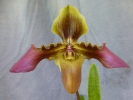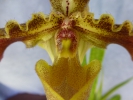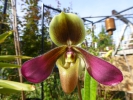|
|
|
|
|
| |
Flasks of
Paphiopedilum esquirolei 'MC3032' × 'JB' |
|
| |
|
|
| |
|
|
Click to Enlarge

Pod Parent Flower |
Click to Enlarge

Offspring 'MC7197' Flower |
Click to Enlarge

Offspring 'MC7197' Closeup of Flower |
Click to Enlarge

Offspring 'MC7197' Flower just after Opening |
| Offspring photos are siblings of the plants you would receive. |
|
|
|
| |
Culture Notes from Donor: Pod parent plant: Temperature range CI (58-75°F). Prefers a cooler, shadier place in the greenhouse. Frequently produces new plant sections. Likes oyster shell in the potting mix.
Comments: Pod parent plant: Flowering cycle is very long. Produces sheaths in summer to fall. Spikes emerge in spring. Seems to need many plant sections in the pot (10 or more) before blooming. Medium-sized plant.
For additional origin/habitat information supplied courtesy of
Charles and Margaret Baker, see further below, near the bottom of this page.
|
Temperatures we attempt to use in the lab & greenhouse:
| For Species: |
|
Spring, Summer, Autumn: days average 77°F, nights 62°F; best fit is Cool-Intermediate 75-58°F
(Source:
Baker's Web OSC) |
| For Species: |
|
Winter: days average 73°F, nights 42°F; best fit is Cool-Cold 64-44°F
(Source:
Baker's Web OSC) |
|
About the name...
| Etymology of |
esquirolei |
|
Named for Esquirol, English orchid collector in the 1st half of the 20th century.
(Source:
Mayr & Schmucker 1998) |
| Etymology of |
Paphiopedilum |
|
From Greek "Paphia" the name of Aphrodite of Cypress; "pedilon", sandal.
(Source:
Pridgeon 1992) |
| Pronunciation of |
Paphiopedilum |
|
paf-ee-oh-PED-i-lum
(Source:
Pridgeon 1992) |
|
If you would like to direct someone to this web page, please copy and paste this URL into your email:
http://troymeyers.com/d?016580
| Flask Information |
| Availability: |
We have sold all of the flasks for this item. |
| You should: |
Consider getting individual plants or compots instead of a flask.
You can place a "Notify Flask Recipients" Request, and either we or a flask recipient may contact you when plants are available.
You may also place a "Notify Retries" Request, and if an identical pollination (the same parents) is done again, we'll let you know.
You may reserve a flask, but it's very unlikely you'll get one ...this could only happen if we found a flask that we didn't know we had. |
| Yield Estimate: |
656 plants (based on flask surveys done 05/26/2009 through 11/11/2009)
|
| Plantlet Sizes: |
From many flasks 15 - 70 mm plants (based on flask surveys done 11/09/2009 through 08/09/2010)
From one most recently surveyed flask 30 - 60 mm (08/09/2010)
|
|
You might also want to:
|
View the seed assay for this item.
View items of the same species.
View items of the same genus.
|
| Ordering Information |
| You are not currently logged in. |
|
You must be a registered user and be logged in to reserve a flask or place a notification request. Please log in:
|
|
|
|
|
|
| |
The origin/habitat information below is supplied courtesy of Charles and Margaret Baker
The following information is based on the name of the plant provided by the donor, and assumes that the name is correct. If the plant has been misidentified, then the following information may not be correct.
This text is copyrighted by the Bakers and may not be reproduced without permission.
ORIGIN/HABITAT: Southwest China in Guizhou, Yunnan, and Guangxi provinces
southward into northern Thailand. Most of the plants in cultivation
labeled as Paphiopedilum esquirolei originated in Thailand, however.
Plants are found at 3950-5900 ft. (1200-1800 m.). The late Dr. Fowlie
(1990) reported that in extreme northwestern Guangxi Province of southwest
China, these plants are often found in the shade of trees on
northeast-facing benches on steep slopes above the openings of limestone
caves where they are bathed in moist air coming from the caves. They have
usually sprouted on lichen encased saplings or tree roots and then sent
their roots through a layer of fallen forest humus and leaf mold to attach
to underlying limestone. Plants were sometimes even rooted in the black,
clay-filled soil. In Vietnam, this lithophytic orchid has been found in
the northeastern province of Cao Bang where it grows on vertical cliffs in
mossy, primary and secondary forests of evergreen and semideciduous trees
at 1150-2950 ft. (350-900 m).
More about this information and the Bakers...
|
|
|
| |
|
|
|